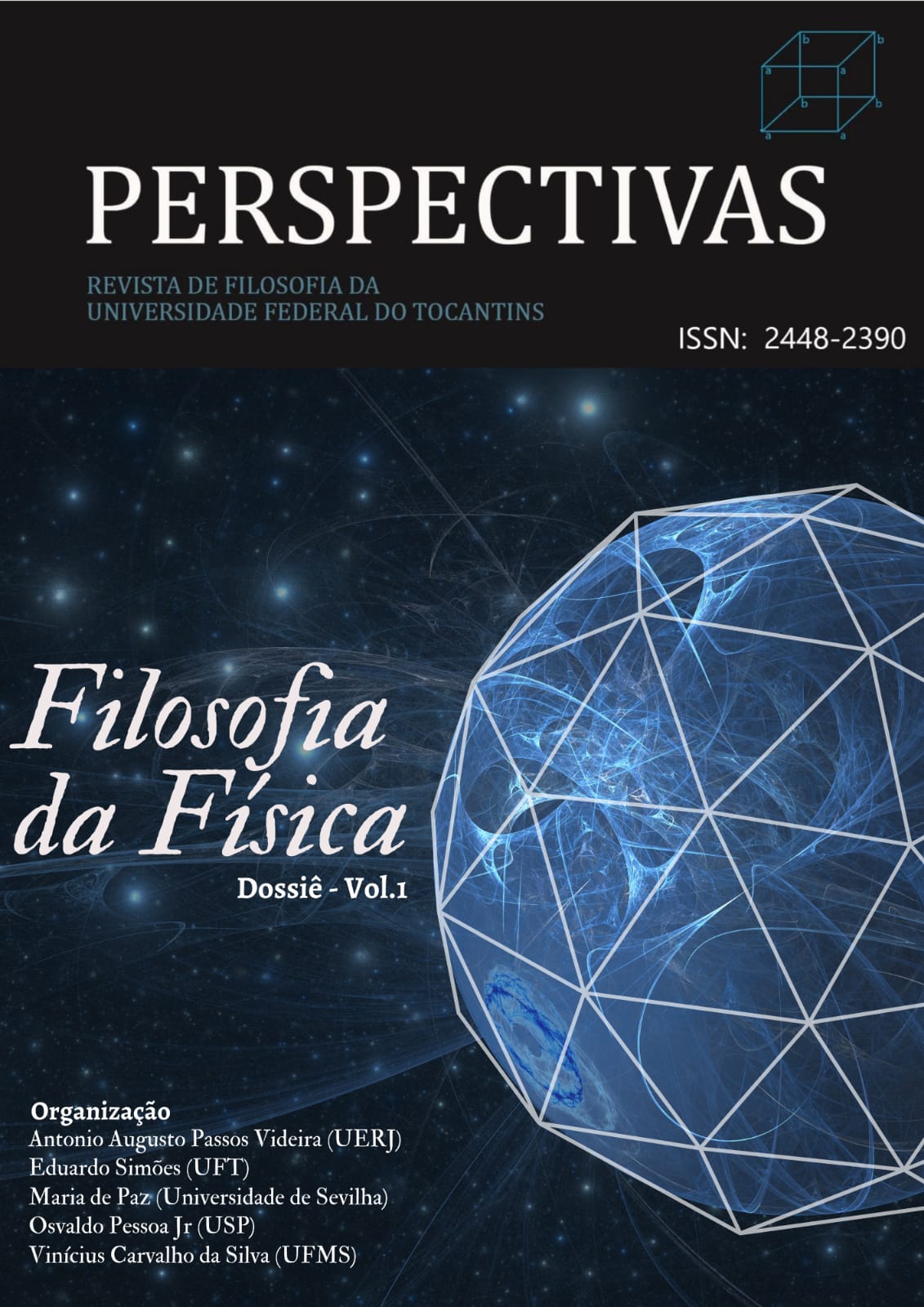The wave-particle duality in Niels Bohr's perspective
DOI:
https://doi.org/10.20873/rpv7n2-51Abstract
This paper discusses the Wave-Particle Duality and the Uncertainty Principle, taken to be expressions of a more general idea, of an interpretive nature: the Complementarity Principle, formulated by the Danish physicist Niels Bohr. It is, as we will argue, an anti-realist interpretation that is founded on the objectivity of physics. The impossibility of using simultaneously the laws of conservation of energy and momentum (claim of causality) and space-time coordination will be discussed, analyzing a possible incompatibility of this complementarity with anti-realism. The quantum measurement process is also discussed from a conceptual and epistemological perspective, and also the meaning of Planck’s constant, emphasizing the idea that, in this orthodox interpretation, the state vector, which contains all the information of the system, has a merely epistemic meaning. Thus, in spite of the extraordinary precision with which quantum theory makes it possible to predict and communicate results of a measurement in a well-defined experimental context, the theory is not concerned with answering what the quantum object is, in the ontological sense, thus giving it its anti-realistic and, at the same time, objective aspect.
References
BOHR, N. O postulado quântico e o recente desenvolvimento da física atômica. In: Pessoa Jr., O. (org.). Fun-damentos da Física, v. 1 (Simpósio David Bohm). São Paulo: Livraria da Física, p. 135-59, 2000. Original: Nature, v. 121, p. 580-590, 1928.
BOHR, N. Atomic theory and the description of nature: Four essays with an introductory survey. Cambridge: Cambridge University Press, 1961.
BOHR, N. A descrição da realidade física fornecida pela mecânica quântica pode ser considerada completa? Trad. C.W. Abramo. Cadernos de História e Filosofia da Ciência, série 1, v. 2, p. 97-106, 1981.
BOHR, N. Física atômica e conhecimento humano. Trad. V. Ribeiro. Rio de Janeiro: Contraponto, 1995.
CARVALHO NETO, R.A. Internalização do significado da teoria quântica do processo de medida de acordo com a interpretação da complementaridade. Tese de Doutorado. Programa de Pós-Graduação em Ensino, Filosofia e História das Ciências, Salvador / Feira de Santana, 2016.
FEYNMAN, R.P.; LEIGHTON, R.B.; SANDS, M. Lições de Física de Feynman: edição definitiva. Vol. III. Trad. A. J. Roque da Silva & S.R.A. Canuto. Porto Alegre: Bookman, 2008.
FREIRE Jr., O. David Bohm e a controvérsia dos quanta. Coleção CLE 27. Campinas: Centro de Lógica e Epis-temologia, 1999.
FREIRE Jr., O.; CARVALHO NETO, R.A. O universo dos quanta. São Paulo: FTD, 1997.
GODOY, W.; PESSOA Jr., O. Juntando EPR e Bell. In: O’LERY, M.; FEDERICO, L. & ARIZA, Y. (orgs.). Filosofía e Historia de la Ciencia del Cono Sur. São Carlos, SP; Buenos Aires: AFHIC, pp. 385-96, 2020.
HEISENBERG, W. Física e filosofia. Trad. J. L. Ferreira. Brasília: Editora UnB, 1987.
HEISENBERG, W. A parte e o todo. Trad. V. Ribeiro. Rio de Janeiro: Contraponto, 1996.
JAMMER, M. The philosophy of quantum mechanics. New York: Wiley, 1974.
KAUARK-LEITE, P. Redefinindo a curvatura do arco: aspectos transcendentais da racionalidade quântica. Analytica, v. 17, p. 59-78, 2013.
KAUARK-LEITE, P. Niels Bohr e a interpretação kantiana da mecânica quântica. Palestra proferida para o Grupo de Pesquisa em Lógica, Linguagem e Ciência, Universidade Federal do Tocantins, por via remota, em 7 de abril de 2022. Online: https://www.youtube.com/watch?v=ldaNv1jqoU0
LAPLACE, P.-S. (2010). Ensaio filosófico sobre as probabilidades. Trad. P.L. Santana. Rio de Janeiro: Contra-ponto/Ed. PUC-Rio.
MACKINNON, E. Bohr on the foundations of quantum theory. In: FRENCH, A.P.; KENNEDY, P.J. (orgs.). Niels Bohr: a centenary volume. Cambridge: Harvard University Press, p. 101-120, 1985.
PAULI, W. General principles of quantum mechanics. Trad. A. Achuthan & K. Venkatesan. Berlin: Springer, 1980.
PERES, A. What is a state vector? American Journal of Physics, v. 52, p. 644-650, 1984.
PESSOA Jr., O. O problema da medição em mecânica quântica: um exame atualizado. Cadernos de História e Filosofia da Ciência, série 3, v. 2, p. 41-81, 1992.
PESSOA Jr., O. O sujeito na física quântica. In: OLIVEIRA, E.C. (org.). Epistemologia, lógica e filosofia da lin-guagem: ensaios de filosofia contemporânea. Feira de Santana: Núcleo de Estudos Filosóficos (UEFS), 2001, p. 157-96.
PESSOA Jr., O. Conceitos de física quântica. São Paulo: Livraria da Física, 2003.
PESSOA Jr., O. O fenômeno cultural do misticismo quântico. In: FREIRE JR., O.; PESSOA JR., O.; BROMBERG, J.L. (orgs.). Teoria quântica: estudos históricos e implicações culturais, Eduepb, Campina Grande: Eduepb; São Paulo: Livraria da Física, p. 279-300, 2010.
TONOMURA, A.; ENDO, J.; MATSUDA, T.; KAWASAKI, T.; EZAWA, H. Demonstration of single-electron buildup of an interference pattern. American Journal of Physics, v. 57, p. 117-120, 1989.
VIANNA, J.D.M. Sobre algumas questões da teoria quântica. In: JAUCH, J.M. São os quanta reais? Trad. J.D.M. Vianna. São Paulo: Nova Stella / Edusp, p. 15-19.
Downloads
Published
How to Cite
Issue
Section
License
Copyright (c) 2023 Rodolfo Carvalho Neto

This work is licensed under a Creative Commons Attribution 4.0 International License.
The Magazine is under the Creative Commons Attribution 4.0 International Public License (CC BY 4.0), according to which:
1) The authors retain the copyright and grant the journal the right of first publication, with the work simultaneously licensed under the Creative Commons Attribution which allows the sharing of articles published with the recognition of authorship and initial publication in this journal.
2) Authors are authorized to enter into additional contracts separately for distribution of the version of the work published in this journal, as long as there is recognition of authorship and initial publication in Perspectivas.
3) Authors are authorized and encouraged to disseminate published texts with proper references to the journal and its authors.





















